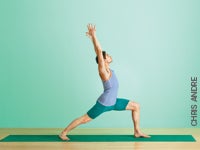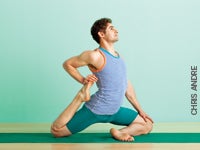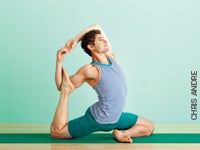Heading out the door? Read this article on the new Outside+ app available now on iOS devices for members! Download the app.
Set sail for Mermaid Pose, on a journey that will open your hips as it lengthens your back into a gorgeous arch. Imagine your foundation for this pose to be like the tail of a mermaid or merman—a powerful and supportive base that allows you an exhilarating sense of fluidity. Your upper body becomes buoyant and free as you discover the extension in your spine and the great opening of your heart.
By cultivating the strength and fluidity of a mermaid throughout this practice, you will increase your capacity to be strong, stable, lighthearted, and graceful, not just here, but in any pose and, indeed, in your whole life. With that in mind, prepare to playfully leave the comfort of the shore and embark on a great adventure.
5 Steps to Mermaid Pose
Before You Begin
Start your practice by sitting for a few moments in quiet meditation. Turn your attention inside as you listen to your breath. Feel gratitude for the simple presence of your breath. Bring your hands together in front of your heart and offer an intention: By cultivating a deeper experience of my strength, may I expand my ability to access the fluidity of graceful freedom.
Come into Balasana (Child’s Pose) and expand your breath in Ujjayi Pranayama (Victorious Breath). As you open from the inside with your breath, soften your eyes, jaw, facial muscles, and skin. Ease into a more fluid awareness by coordinating the movements of your body with the movements of your breath.
Transition to Cat-Cow Pose and move your body with the wavelike pulsation of your breath as you flex and extend your spine. After a few rounds, reverse the pattern so that you inhale during the cycle of movement where you previously exhaled, and vice versa. Cultivate a supple quality in your spine as you synchronize your movement and breath. Notice any places where you might feel stuck or tight.
Continue to move with your breath as you warm your muscles and joints in three rounds of Surya Namaskar A and B (Sun Salutations A and B). As your body warms up, start to cultivate strength through your legs and arms as you move through the Sun Salutations and encourage your mind to let go of unnecessary thoughts and soften into the experience.
Adho Mukha Svanasana (Downward-Facing Dog Pose)

Adho Mukha Svanasana is a fantastic pose to align and open the whole body and create freedom and length in your spine. The muscles in your legs, pelvis, and low back stretch, open, and release in a forward bend while your upper back, shoulders, and arms get a full stretch that will prepare you to lift your top arm up and over your head to bind with your bottom hand in Mermaid Pose. Holding Down Dog for a few minutes not only builds strength but also quiets your mind and nervous system, just as an inversion does, since your head is below the level of your heart.
To come into Downward-Facing Dog Pose, start on your hands and knees. Place your hands so that your wrist creases are parallel to the front edge of your mat and the centers of your wrists are in line with your outer shoulders. Move your knees a few inches behind your hips.
As you inhale, expand your inner body by filling your back and side ribs with your breath, and lengthen from your hips to your shoulders until you feel that you are slightly shrugging your shoulders to create this length. Make your arms straight and strong. On an exhalation, soften your upper back between your shoulder blades by letting your heart melt toward the floor. As you do this, encourage a growing feeling of integration in your shoulders, shoulder blades, and spine.
With your next breath, come into Adho Mukha Svanasana: Lift your knees off the floor, stretch your hips up and back, straighten your legs, and push through your arms. Now, fully engage your arms and legs, pulling them toward each other isometrically, and draw strength and power from your hands and feet up your arms and legs into the base of your heart. Maintain this strength as you actively stretch from your heart down through your arms as well as up and back through your hips and down through your legs.
The more you maintain the strength and stability that come from your arms and legs, the more you’ll open to the feeling of fluidity in this pose, expressed through the suppleness felt along the length of your spine. Keep your hips, spine, and arms in a continuous line, and your elbow creases facing each other.
Over time, you may continue to deepen the strength and stability in the foundation of your legs and arms. The suppleness of your spinal stretch may also continue to increase until your neck lengthens and releases, and your head touches the floor. Be patient. It takes practice and a teacher’s guidance to unfold the pose in this classical form without misaligning your shoulders, arms, upper back, or legs.
If you experience any pinching in your shoulders, elbows, or neck, lift your chest and arms a few inches (as if you were going into Plank Pose) and again melt your heart in between your shoulder blades. This will stabilize and align your arms and shoulders. From this renewed strength, actively stretch your heart back toward your legs. Balance the strength of integration with the feeling of fluidity that comes from spinal extension. Hold the pose for two to three minutes with deep, even breathing. Rest in Child’s Pose as needed.
Virabhadrasana I (Warrior Pose I)

Because strong legs provide the foundation for a deeper opening in the pelvis and spine, Virabhadrasana I is an ideal preparation for Mermaid Pose. The powerful stance of the legs and the lift of your spine up through your heart and arms produce a literal reach. The pose reflects and exalts your ability to reach deep inside to the source of your strength and the exhilarating freedom you feel in extending up through your spine.
From Adho Mukha Svanasana, catch the wave of an inhalation and lift your left leg behind you. Then, on an exhalation, step your left leg forward between your hands. Put your right heel on the floor, with your right foot at a 45-degree angle, toes facing inward. Keep your right leg straight and strong, and bend your left knee to 90 degrees. Your front heel should be in line with your back heel. On an inhalation, lift your torso and actively stretch your spine up from the core of your pelvis. Stretch your arms up, take your head back, and look up past your palms.
Once in the pose, powerfully square your hips to the front with the strength of your legs as you pull from your feet into the core of your pelvis. Continue to flex your left knee so your thigh stays parallel to the floor and your left shin remains perpendicular to the floor.
Keep building the stability of your foundation through this strong work in your legs as you turn your right leg and hip in, move your right inner thigh back, and widen your right thigh and hip laterally. Move the sides of your waist back, scoop your buttocks and coccyx down, and engage your pelvic-floor muscles and abdominal muscles as you draw your lower belly in and up.
From this strong and stable form, stretch out through your legs and feel the suppleness extend up through your spine to create the exhilaration of freedom. Breathe deeply and evenly. Hold the pose for 5 to 10 breaths; then release and repeat on the right side.
Anjaneyasana (Low Lunge), variation

This Anjaneyasana (Low Lunge) variation builds on the work of Virabhadrasana I, further strengthening the legs and pelvis to support the feeling of fluidity through length and extension in your spine.
From Down Dog, ride the inhalation to lift your left leg up and back, and on an exhalation, step your left foot between your hands to move into Anjaneyasana. Bend your right knee and release it to the floor. If you feel any discomfort in your right knee, you can use a blanket or a folded mat as padding.
Stretch your torso and arms up, and square your hips and chest to the front of your mat. Scoop your buttocks and coccyx down as you engage your pelvic floor and abdominal muscles. Draw your lower belly in, feeling how the tone in your pelvis and belly supports your lower back.
Now start to lower your right arm and reach back to hold your right ankle. Push down through your right arm to create more power to stretch your spine. If reaching for your ankle creates discomfort in your lower back, bring your right hand to your calf or to the floor or to a block outside and behind the right hip. You might have shifted your hips back and turned slightly to reach your ankle, so square your pelvis and chest to the front edge of your mat again by pulling energy up from your feet into your hips.
Maintain this strength in your legs as you stretch from the core of your pelvis through your legs. Keep lifting through your spine as you pull both shoulders back. Now slide your shoulder blades down your back, lift your chest, and stretch up and back through your left arm. Take your head back and gaze past your left hand. Once you come into your fullest expression of the pose, hold for 5 to 10 breaths; then release and transition into Adho Mukha Svanasana before switching sides.
With practice, you can keep your legs in position while you switch arms, touching the floor behind and outside the hips with alternating hands. Take a few breaths on each side. Then try moving your arms more fluidly, as if you were swimming the backstroke. Over time, you will increase the strength and power in your legs and core to support the pose. You will also increase the fluidity of your movement while maintaining the feeling of freedom in your spine.
Eka Pada Rajakapotasana (One-Legged King Pigeon Pose), Variation

This particular variation of Eka Pada Rajakapotasana builds on the previous poses and actions to help you establish the position for the legs and pelvis in Mermaid Pose.
From Adho Mukha Svanasana, use an inhalation to lift your left leg back, and on an exhalation, catch the ascending wave and bring your left knee toward your left wrist, placing the left shin down in a diagonal line across your mat.
Make your legs strong and draw your legs isometrically into the midline of your mat. From your feet and knees, pull power up into the core of your pelvis. As an exercise, do this until your pelvis actually lifts up, and use the strength of your legs to create the stability from which you can open to the exhilaration of extending up through your spine. This action in your legs is a key element in keeping the length in your spine and avoiding compression in your low back. Maintain the active stretch through your spine and now extend from your pelvic core out through your legs.
Continue to support the lift in your torso with the strength of your legs. Rest your left hand on your left thigh. Bend your right knee, reach back with your right hand, and hold the inner edge of your right foot, with your thumb toward the sky. Turn your right leg in until the front of your thigh faces the floor. Then move the thigh back, reaching your right sitting bone toward your right heel as you draw your right foot toward the outer edge of your right hip.
If you have the flexibility, shift your right hand so that the fingers point toward the floor and the palm presses into the top of your foot. If tightness in your right thigh keeps you from bringing your right foot forward and down enough to shift your hand in this position, continue to practice by holding the inner edge of your back foot until you’ve developed the flexibility to move deeper into the pose.
Once in the basic pose, square your pelvis and torso to the front edge of your mat, move the sides of your waist back, scoop your buttocks and coccyx under, engage your pelvic floor and abdominal muscles, and stretch up through your spine. Keep lifting up through your spine as you actively extend out through your legs, putting more of your legs and pelvis back down onto the floor.
Hold for 5 to 10 breaths, and explore the actions of your legs and their effect on your spine as you pulse with the breath. Use your inhalations to renew the strength of your legs and maintain the lift of your spine. On your exhalations, ground your pelvis by pushing out through your legs. Release your right foot carefully and step back to Down Dog for the second side.
This pose will lengthen your quadriceps and hip flexors and help open your lower back, preparing you for Mermaid Pose. As your body becomes more aligned through practice, you’ll continue to open physically and energetically, increasing the fluidity and freedom of your actions.
Mermaid Pose

Now you are ready to summon the strength and fluidity that you have built in the previous poses and set sail.
First, come back into Pigeon Pose with your left leg forward. Again, bend your right knee deeply, holding your right foot with your right hand and bringing your left hand to your left thigh. Slide your right foot along the inside of your right forearm until you can hold it in your elbow crease. Press your right foot back into your upper arm where it meets your elbow. As you hug your right foot in toward you, create exquisite counter tension by pressing your right foot back against your arm.
Continue to generate the lift of your spine with the power of your legs as you pull from your feet and knees into the core of your pelvis. Lift your left arm overhead and pull your shoulder back as you slide your shoulder blade down your back. Bend your left elbow, put your forearm behind your head, and press your upper arm back with your head until you can clasp your hands. If you find that this reach is too intense, loop a strap around your right foot to hold with your left hand, or release your left hand back onto your left thigh for support.
Once you are in the pose, square your pelvis and torso forward by pulling from your feet and knees into your pelvic core. Maintain this strength as you stretch your spine up with freedom, and actively push out through your legs as you lengthen them away from each other. Hold for 5 to 10 breaths; then release, step back to Downward-Facing Dog, and repeat Mermaid Pose on the other side.
To transition from the exhilaration of practice to the delicious release of rest, stretch your whole body in Downward-Facing Dog. Then continue to cool down and come back to center with Uttanasana (Standing Forward Bend), Child’s Pose, Ardha Matsyendrasana (Half Lord of the Fishes Pose), and Paschimottanasana (Seated Forward Bend). To finish, rest in Savasana (Corpse Pose).
Over time, you can continue to cultivate your strength and fluidity with this powerful and graceful pose. You may find that the depths of your practice will repeatedly delight and surprise you as you continue to align your body, mind, and heart. May this practice on the mat enable and empower you to navigate the challenges of your life with grace.